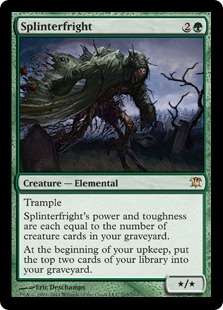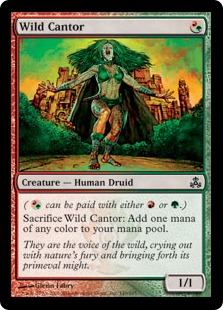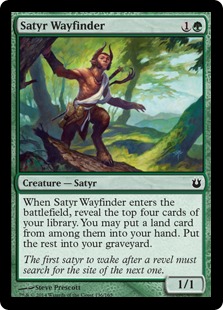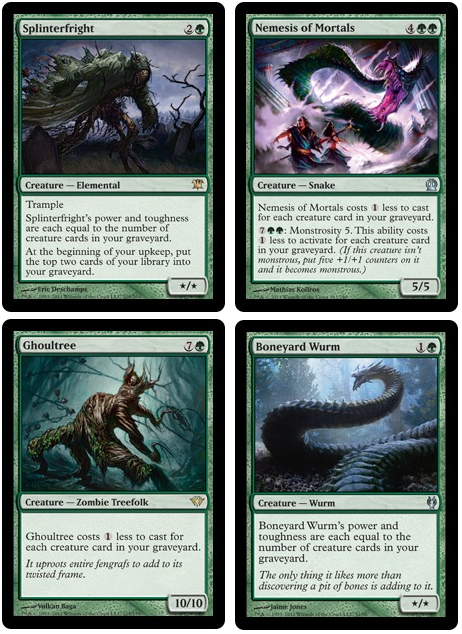First of all, I want to personally thank Jeff and Jason Abong for giving me the opportunity to write for AZMagicPlayers.com. It’s probably kind of a gamble giving a scrub like me a voice through their website. That being said, I am really excited to begin this endeavor. I have always wanted to try my hand at writing Magic articles, but I never really knew what to write about. I finally have an idea that excites me, but I must admit it is fairly bizarre: I want to share the adventures I’ve had creating and playing budget decks on Magic Online. Sound a little far fetched? I urge you to read on anyway.
This idea of mine might actually make sense if I tell you a little about myself first. My name is Alex Kiracofe and I really enjoy playing the game Magic: The Gathering. I would go as far as to say that Magic is my favorite game of all time, beating out all other card games, board games, and video games.
Like most of you, I enjoy playing at our local game shops here in Arizona. However, it has become increasingly difficult for me to find the time to get out and attend tournaments lately. I actually haven’t been to a tournament in over six months. So how do I cope with Magic withdrawal? Easy, MODO of course! [Editor’s note: MODO stands for Magic Online with Digital Objects – the original name for Magic: the Gathering Online but still used by many players today] I am sure some of you have already turned to Magic Online because of how easily you can fit it into your busy schedules. I actually just began taking advantage of this convenience recently.
I am not advocating that we should use Magic Online exclusively over playing at our local game shops. There are some awesome shops here in Arizona and we should be supporting them at every opportunity. MODO is simply the tool I use to create and test out my decks. Hopefully I will have a chance to get out and play in person again soon. Maybe you’ll see me with the deck I discuss later in this article.
It is no secret that Magic Online can be really expensive and time consuming. Knowing that I have neither the time nor skill to “go infinite” or any such nonsense, I take a more casual approach to the online game. It all begins with deck building, which is pretty much my favorite aspect of Magic. I think of it as a creative outlet of sorts. I love the convenience of building a deck and immediately being able to test it out against other competitors online. Surprisingly, this process has been both fun and affordable for me. There are tons of really sweet cards that can be bought online for just pennies!
When it comes time to try out my decks, I head for the “Casual Play” submenu within Magic Online. There are several options there, but the only two I use are “Just for Fun” and “Tournament Practice.” Both have their merits, but I tend to prefer the Tournament Practice room. The players in there seem better, and most of them are playing quality decks. Yeah I take some lumps running my budget decks against their higher tiered strategies, but it’s all good. Playing against competent players helps me improve my decks and become a better player myself.
I suspect that some people in Tournament Practice room rage quit on me from time to time. Maybe they would rather focus on what’s in their meta instead of facing my rogue strategy? I think it’s more likely that they were terrified by my turn one Splinterfright and had to concede so they could change their pants.
Some of you are probably wondering why I don’t use Magic Workstation or Cockatrice. After all, those sites are dedicated to deck creation and they cost nothing to use. I did play Cockatrice for a while, but I definitely prefer the mechanics of Magic Online. Plus the competition on MODO is way better, and I don’t have to argue with people who don’t understand what their cards do. Those sites are cool since they are free, but I really don’t feel like I have spent that much money doing what I do on Magic Online.
Admittedly, I haven’t tried any of my decks out in actual tournaments. I honestly don’t have the time or money for tournaments right now, not even on MODO. Although I do miss the excitement that comes with competing in a tournament, I am having plenty of fun playing casually for now.
Well now that I have finished my long winded introduction, allow me to share my first deck. I call it, “Splinterfright Stompy.” Yeah it’s kind of a lame deck name. Whatever. If you have a better idea for the deck name then let me know in the comments.
| Fatties (14) 4 Splinterfright 4 Boneyard Wurm 4 Nemesis of Mortals 2 Ghoultree Enablers (20) 4 Wild Cantor 4 Sakura Tribe-Elder 4 Simian Spirit Guide 4 Satyr Wayfinder 4 Street Wraith Spells (8) 4 Commune with the Gods 2 Rancor 2 Mulch Lands (18) 17 Forest 1 Mosswort Bridge |
First of all, I would like to point out that this Modern legal deck plays a whopping 12 cards from Theros block. Woot woot! Thanks Theros, you’re the best!
The concept of this deck is pretty simple (it practically built itself). You basically just want to quickly fill your graveyard with as many creatures as possible. This in turn allows you to put some rather large creatures on to the battlefield. This deck is a bit of a glass cannon, seeing as how we are investing most of our resources into casting an early fatty or two. Luckily, these Boom Booms dwarf the most of the dudes that our opponents play and they should carry us to victory if not answered.
It probably looks odd that this deck contains several 6 and 8 drops while only playing 18 lands. Well, we need our deck to be packed creatures that we can mill into our graveyard. This makes Splinterfatty happy while considerably reducing the casting cost of those high drops I mentioned. I have cut as many lands as possible to help us reach this critical creature density. Fortunately, there are plenty of cards in this deck that help fill the roll of the absent lands.
Notice how I divided the creatures in the deck list. There are our fatties, aka Boom Booms, aka win-cons, and they are the muscle behind this deck. There are also our enablers, and they are as equally important as the Boom Booms. They are the reason we can play so few lands. They are the reason we cast such large creatures at bargain basement prices.
Wild Cantor may look like an odd choice, but it fills two important rolls in this deck. Sacrificing it not only provides us with some much needed mana acceleration, it also adds to the creature count in our graveyard. Playing a turn two (or turn one) Splinterfright can be a pretty good start for this deck. Other mana dorks, such as Arbor Elf could get us to 3 mana on turn two, but we can’t cast Splinterfright if there isn’t a creature in the graveyard yet. Wild Cantor gives us the mana we want and the dead body that we need. It also functions as a pseudo Rite of Flame when ramping up to cast Ghoul Tree. Try wrapping your head around that (Tinder Wall would be a virtual Dark Ritual by the same logic).
Sakura Tribe-Elder is a really nice addition to this deck. We’d probably rather have Tinder Wall instead, but this isn’t Legacy. Mr. Tribe-Elder not only fetches us a precious land, but he also kindly donates his corpse to Spinterfight and pals during the process. As most of you are aware, he also chump blocks nicely since you can sac him and fetch a land before damage. We can also cast our favorite tribesman turn one if he is in our opening hand with this next card…
Simian Spirit Guide – Elvish Spirit Guide’s ugly cousin. If we could chose between the two cards, I imagine we’d go with the green one. Nothing personal against ol’ Simian, but it kind of bugs me that we can’t hard cast him without engaging in some silly Wild Cantor shenanigans. Is it a problem that we can’t cast him? Not really. We’re mostly just after the mana he produces, even if it is the wrong color. We could just play extra lands instead, but they don’t add to the body count when milled into our graveyard. Note that I am currently testing a split of 2 Arbor Elves and 2 Simian Spirit Guides. It is nice that the Elves stick around to help longer than one-shot Simian. They’re certainly not as flashy though.
To say that I was “excited” when Satyr Wayfinder was first spoiled last month would be the understatement of the century. I was already having a blast with this deck before, and it has become more even more fun since the Satyr’s release. It is similar to Mulch in that it finds us precious lands while binning creatures for our Boom Booms. Where the Satyr outshines Mulch is in the fact that it is a creature instead of a sorcery. It attacks, it blocks, and it even keeps contributing after finding its way into our graveyard.
Street Wraith’s role in this deck is to hit the bin. Period. There is no hard casting this guy, unless we’re talking Urborg or more Wild Cantor shenanigans. Cycling him costs 2 life but gives is more than just a card in return. Early game, his presence in the ‘yard allows us cast our otherwise 0/0 Splinterfrights and Bonyard Wurms. Later on, cycling him gives those guys a zero mana, uncounterable instant speed +1/+1 bonus. This can be pretty hilarious, especially against burn spells. Side him out against aggro decks though. The 2 life hurts too much in those matches.
The Boom Booms (Splinterfright, Boneyard Wurm, Nemesis of Mortals, and Ghoul Tree) probably don’t need much explanation. Their role is pretty simple, which is mostly just to Hulk out and smash stuff. Goyf-Confidant is clearly the best of the bunch, but the others are good too. Turns out that playing a 5/5 on turn two or three is pretty good when Lightning Bolt is the format’s defining removal spell. It may be difficult to visualize the efficiency of these creatures through the context of this article, but trust me. They hit fast and they hit hard. There are obviously plenty of cards that answer them, but you might be in trouble if you don’t find one quickly.
Commune with the Gods is one of the best cards in this deck. Not only is it basically Boom Booms #15-18 (since it helps you dig for one of those guys), it also fills our ‘yard with more bodies. What’s not to love? Oh, and as a sweet bonus it also helps us find Rancor too!
Speaking of Rancor…most of our Boom Booms are rather vanilla without it. Rancor lets us trample through would be chumps and can help win us games we would otherwise lose. As important as that is, I feel we’re fine playing only two copies main deck. Commune with the Gods makes them easier to find..
I originally played 4 copies of Mulch, but reduced that number to 2 when Satyr Wayfinder was released. Mulch is still a great card for us though. It turns out that grabbing lands and binning dudes are two things that really help this deck function smoothly.
The last card I want to want mention is MosswortBridge. I like it. There is usually something scary hiding under it. Since there is only one copy in the deck, the fact that it enters the battle field tapped rarely slows us down. Playing more than one copy could be a bit clunky though.
There is so much more I want to say about this deck, but I think that this is enough for one article. Next week, I will be back to break down some game play and sideboarding with this deck. I also want to share my list for the Legacy version of this deck (it’s pretty spicy). Until then, feel free to reach me through the comments. I would like to know what you think of this article and the possibility of me writing about more budget decks in the future. You should also look for me in the Modo Casual Play area. My user name is Keenwa1. Thanks for reading!





I like the idea. It seems like the deck could really use life from the loam over say mulch. Also a really good cards that would work well is Bloodghast, Vengevine, and Grisly Salvage as its the best 2 mana dig you can get. Going black like that is super easy in modern due to fetches.